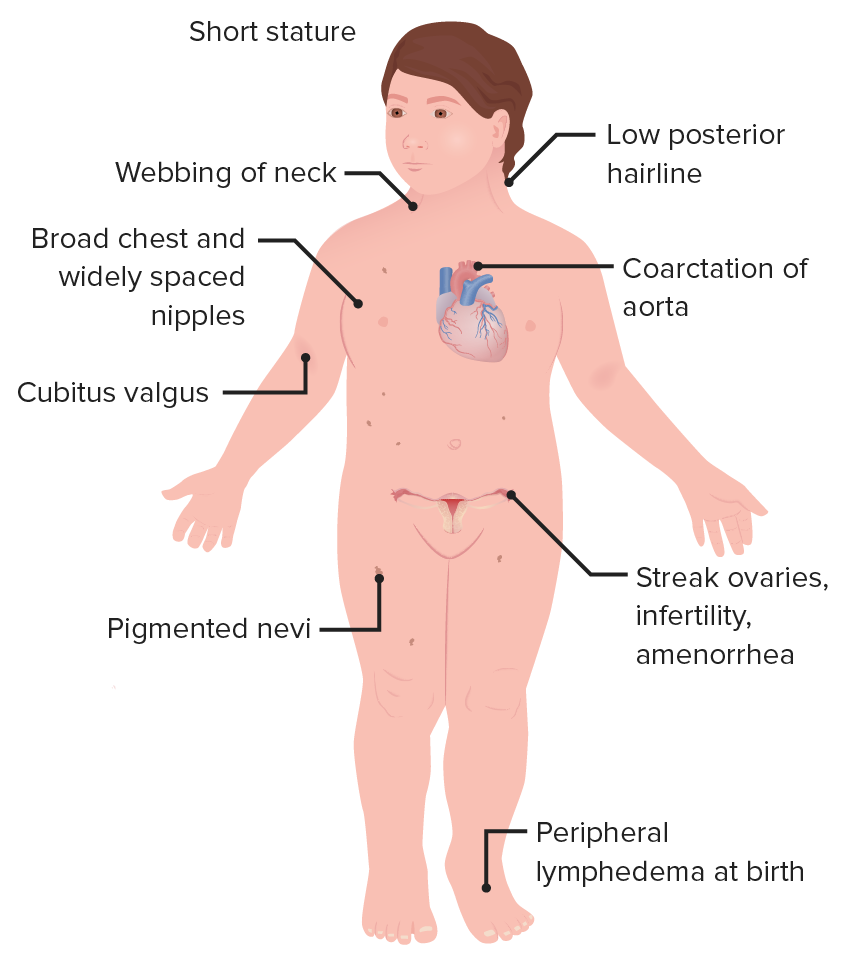Playlist
Show Playlist
Hide Playlist
Turner Syndrome: Management and Complications
-
Slides Turner Syndrome.pdf
-
Download Lecture Overview
00:01 Now, this is more detailed information about cardiovascular screening. I doubt that you’ll be examined on this. 00:07 But if you’d like to download this to get more information, you can do so now or you can skip to the next part of the lecture. So, in Turners patients, we screen them at the time of diagnosis. 00:19 So hopefully, that will be either a prenatal or postnatal diagnosis early on in life. 00:24 They should be evaluated by a cardiologist who has expertise in congenital heart disease. 00:30 They should have a comprehensive exam including a blood pressure in all extremities. 00:34 All require imaging of the heart, the aortic valve, the aortic arch, and pulmonary veins. 00:42 They also require an echocardiography in their infancy or as a young girl. MRI and echo should be done in older girls and adults. Lastly, they should have an EKG. They should always have follow up depending on the clinical situation but most require a follow-up. For patients with apparently normal cardiovascular system and age-appropriate pressure, they can be followed normally. 01:09 Reevaluation with imaging should occur at timely occasions as they transition to an adult clinic or before attempting pregnancy or the appearance of new onset hypertension. 01:19 Otherwise, you should image every five to ten years. For patients with cardiovascular pathology, treatment and monitoring should be determined by a cardiologist, again with expertise in congenital heart disease. What can we do about the growth problem that we have in Turner syndrome patients? Well, the FDA approved growth hormone in 1996. 01:45 Most Turner syndrome patients will be taking this as this is the standard of care to increase their linear growth velocity. The best outcomes occur when this is administered to very young patients when they have a high dosage in a long duration. They can regain 7 to 18 centimeters of their height. 02:04 Recall that they are 20 centimeters shorter than their peers. So, if they take growth hormone, they can have good outcomes. Alternative adjunctive therapy is oxandrolone. 02:16 However, this is very detailed. If you’d like to have more information about this, you can download the supplemental information. Let’s now review hormone replacement in the Turner syndrome patient. 02:27 Remember that when we initiate estrogen, we try to mimic normal physiology. 02:33 Once the patient has fully developed normal contour of adult breast and/or they have breakthrough bleeding, then only then will we initiate progestins. This is important because if we initiate progestins too early, they will have tubular breast formation which can cause a lot of psychologic distress and anxiety. Also, they will have reduced potential for their uterine growth which is important should they still desire to carry a pregnancy. This hormone replacement therapy is done in the context of their growth hormone administration. Recall that growth hormone administration will cause you to regain some of the height that is usually lost with Turner syndrome patients. 03:17 So therefore, we do not want to initiate hormone therapy too aggressively until they have reached their adult potential growth height at least as close as possible. We have more detailed information about the different protocols of hormone administration. Let’s now talk about pregnancy in the Turner syndrome patient. As you know, Turner syndrome patients can be mosaic and they may have some residual ovarian function. This can lead to a spontaneous pregnancy. 03:48 These patients need to be counseled about this possibility. This occurs in 2% to 5% of Turner syndrome patients. There is a risk though of dissection of the aorta in 2 out of 100 pregnancies of Turner syndrome patients. Remember, this can be on your test as this can be life-threatening and fatal. 04:09 In seven cases of aortic dissection reported after assisted reproductive technologies, six patients die. 04:16 I want to leave you here with a statement about pregnancy from the American Society for Reproductive Medicine. Turner syndrome is a relative contraindication for pregnancy. 04:27 Patients should be encouraged to consider alternatives. Alternatives would include adoption of a child, embryo adoption, or oocyte donation with their partner’s sperm or a semen donor. 04:42 However, pregnancy of any sort is dangerous and the patient should be counseled that it can be fatal. 04:49 Half of all aortic dissections can occur in pregnancy or in the postpartum time. 04:57 Postpartum usually refers to the six weeks after pregnancy. This usually occurs because there is some vascular remodeling which occurs during pregnancy which can put them in an increased risk of aortic dissection. In summary, remember to check karyotype on any girl with pubertal delay or unexplained growth failure. Women with Turner syndrome are at increased risk of aortic dissection, premature death after pregnancy. They should be counseled as such before pursuing any type of pregnancy. Hormone replacement therapy protects Turner syndrome patients from osteoporosis. They should initiate hormone replacement when the girl is psychologically ready and when it would typically happen in a normal child. 05:42 Remember the ABCs of Turner syndrome which was presented earlier in this lecture. 05:47 Let’s now go through a case of a woman who presents to your office with Turner syndrome. 05:53 So this patient is a 36 year-old G0, therefore she’s never been pregnant who presents to your clinic to discuss egg donation versus embryo donation. Recall that Turner syndrome is a relative contraindication to pregnancy. So what would you tell her? One, what are the risks that are involved with becoming pregnant if you have Turner syndrome? As we’ve discussed before, these patients are at increased risk of aortic dissection which can be fatal. 06:19 How would you counsel this patient? What would you counsel her? Well again, the ASRM guidelines state that it’s a relative contraindication and that she should consider alternative ways to build her family whether that be through adoption or consider not having a child at all. 06:38 What tests would you order? In this case, remember that they have a cardiac abnormality profile. 06:45 So, they need to be seen by a specialist in congenital cardiac anomalies. 06:50 That usually includes ordering an echo and an MRI. How should her pregnancy be managed? Recall these patients will be a high-risk pregnancy not only because of their hypertension, they may develop hypertensive disease during pregnancy. Also because of their glucose intolerance, they may develop diabetes during pregnancy. But also because of the risk of aortic dissection, they need to be managed by a maternal fetal medicine consultant. 07:17 Thank you for listening. If you have any questions, please don’t hesitate to review the slide set again.
About the Lecture
The lecture Turner Syndrome: Management and Complications by Lynae Brayboy, MD is from the course Normal Puberty and Disorders of Sexual Development. It contains the following chapters:
- Turner Syndrome: Management
- Pregnancy and Turner Syndrome
- Egg Donation vs. Embryo Donation: Case Study
Included Quiz Questions
Which of the following is NOT a screening modality for heart abnormalities in patients with Turner syndrome?
- Angiography
- EKG
- ECHO in younger patients
- MRI and ECHO in older patients
- Blood pressure measurements in all extremities
A 15-year-old girl presents to the clinic with fainting attacks. Her blood pressure is 120/80 mm Hg on the right arm but has 90/60mmHg on the other. Her pulse is delayed on her left side. She has a karyotype of 45,XO. What is cardiovascular abnormality expected in such a patient?
- Coarctation of aorta
- Aortic aneurysm
- Aortic dissection
- Patent ductus arteriosus
- Ventricular aneurysm
Which of the following situation warrants evaluation of the cardiovascular status in a patient with Turner syndrome?
- Before attempting pregnancy
- During the period of Pubarche
- Before starting oral contraceptive pills
- Every 15 years
- Before starting graduate school
Which cardiovascular complication is closely associated with patients with Turner syndrome getting pregnant?
- Aortic dissection
- Coarctation of the aorta
- Aortic aneurysm
- Aortic atherosclerosis
- Ventricular aneurysm
Customer reviews
5,0 of 5 stars
| 5 Stars |
|
5 |
| 4 Stars |
|
0 |
| 3 Stars |
|
0 |
| 2 Stars |
|
0 |
| 1 Star |
|
0 |




